
|
cholesterol |
cholesterol is a lipid of Sterol Lipids (ST) class. Cholesterol is associated with abnormalities such as Trypanosomiasis, Chagas Disease, Cleft Palate, Chondrodysplasia punctata 2, X-linked dominant and Child syndrome. The involved functions are known as Blood Circulation, Sterol Biosynthesis Pathway, Receptor Mediated Endocytosis, Methylation and Signal. Cholesterol often locates in Animal tissue, Blood, Membrane, Plasma membrane and peroxisome. The associated genes with cholesterol are MBD2 gene, SIM, SLC33A1 gene, Genome and NSDHL gene. The related lipids are Sterols, zymosterol, fecosterol, Total cholesterol and 7-dehydrocholesterol. The related experimental models are Mouse Model, Knock-out, Genetically Engineered Mouse and Disease model. |
98461 |

|
acetic acid |
acetic acid is a lipid of Fatty Acyls (FA) class. Acetic acid is associated with abnormalities such as Vitamin B 12 Deficiency. The involved functions are known as Excretory function. The related lipids are Propionate. |
89633 |

|
doxorubicin |
Adriamycin is a lipid of Polyketides (PK) class. Adriamycin is associated with abnormalities such as Cardiomyopathies. The involved functions are known as Transcription, Genetic, Process, Drug effect disorder, Diastasis and Oxidation-Reduction. Adriamycin often locates in Muscle, Myocardium and Entire gastrointestinal tract. |
54913 |

|
Prostaglandin E2 |
Prostaglandin E2 is a lipid of Fatty Acyls (FA) class. Prostaglandin e2 is associated with abnormalities such as Renal glomerular disease, Arthritis, Degenerative polyarthritis, Pancreatitis and Rheumatoid Arthritis. The involved functions are known as enzyme pathway, Atherogenesis, Anabolism, inhibitors and Oxidants. Prostaglandin e2 often locates in Tissue membrane, Blood, Extracellular, Membrane and Protoplasm. The associated genes with Prostaglandin E2 are PTGS2 gene, TP53 gene, TNFRSF5 gene, FASTK Gene and TNF gene. The related lipids are Lipopolysaccharides, Steroids, monooxyethylene trimethylolpropane tristearate, Fatty Acids, Unsaturated and Promega. The related experimental models are Arthritis, Adjuvant-Induced, Xenograft Model, Experimental Autoimmune Encephalomyelitis, Cancer Model and Knock-out. |
49278 |

|
phorbol 13-acetate 12-myristate |
Phorbol 13-acetate 12-myristate is a lipid of Prenol Lipids (PR) class. The involved functions are known as DNA Fragmentation, Phosphorylation and Irritation. Phorbol 13-acetate 12-myristate often locates in low-density lipoprotein particle. The associated genes with phorbol 13-acetate 12-myristate are FPR1 gene and ABCB1 gene. |
40921 |

|
Pyruvic acid |
Pyruvic acid is a lipid of Fatty Acyls (FA) class. |
27047 |

|
forskolin |
Forskolin is a lipid of Prenol Lipids (PR) class. Forskolin is associated with abnormalities such as Cholestasis, Vocal cord dysfunction familial, Hypothyroidism, Renal tubular disorder and Disintegration (morphologic abnormality). The involved functions are known as Cell Proliferation, Anabolism, mRNA Expression, Agent and Signal. Forskolin often locates in Extracellular, Body tissue, Skin, Tissue membrane and Membrane. The associated genes with forskolin are P4HTM gene, SLC33A1 gene, NR1I2 gene, Genes, Reporter and CYP3A gene. The related lipids are Steroids, steroid sulfate, Fatty Acids, LYSO-PC and Lipopolysaccharides. |
24755 |

|
Arachidonic acid |
Arachidonic acid is a lipid of Fatty Acyls (FA) class. Arachidonic acid is associated with abnormalities such as Atherosclerosis, Ischemia, Hypertensive disease, Hypertension induced by pregnancy and Vascular ring of aorta. The involved functions are known as Platelet aggregation, Anabolism, Ion Transport, Signal Transduction Pathways and Signal. Arachidonic acid often locates in Extracellular, Body tissue, Protoplasm, Tissue membrane and soluble. The associated genes with Arachidonic acid are CYP2J2 gene, CYP2E1 gene, Recombinant Proteins, POR gene and P4HTM gene. The related lipids are Fatty Acids, Glycerophospholipids, Steroids, octadecadienoic acid and 9-hydroxy-10,12-octadecadienoic acid. The related experimental models are Mouse Model and Knock-out. |
22864 |

|
erythromycin |
erythromycin is a lipid of Polyketides (PK) class. Erythromycin is associated with abnormalities such as Systemic Inflammatory Response Syndrome, Pneumonia, Infection, Pneumococcal Infections and Exanthema. The involved functions are known as Pharmacodynamics, Sterility, Agent, Drug Kinetics and Adjudication. Erythromycin often locates in Blood, peritoneal, Extracellular, Ribosomes and apicoplast. The associated genes with erythromycin are P4HTM gene, SLC33A1 gene, FAM3B gene, Operon and Homologous Gene. The related lipids are Hydroxytestosterones, Steroids, Propionate, Mycolic Acids and campesterol. The related experimental models are Mouse Model and Knock-out. |
19871 |

|
4-aminobutyric acid |
4-aminobutyric acid is a lipid of Fatty Acyls (FA) class. 4-aminobutyric acid is associated with abnormalities such as Epilepsy and Premenstrual syndrome. The involved functions are known as Binding (Molecular Function), neuron survival, Process, Uptake and physiological aspects. 4-aminobutyric acid often locates in Microglial, Neurofilament, Neuraxis, Brain region and Neurites. The associated genes with 4-aminobutyric acid are arginine methyl ester, SLC33A1 gene, NKS1 gene, P4HTM gene and ITSN2 gene. The related lipids are pregnenolone sulfate, pregnane-20-one, Pregnanes, Steroids and endogenous steroids. |
19702 |

|
11beta-PGF2 |
11beta-pgf2 is a lipid of Fatty Acyls (FA) class. |
15009 |

|
tacrolimus |
Tacrolimus is a lipid of Polyketides (PK) class. Tacrolimus is associated with abnormalities such as Renal glomerular disease. The involved functions are known as inhibitors, Fungicidal activity, Metabolic Inhibition, Excretory function and Dephosphorylation. Tacrolimus often locates in Hepatic, Mitochondrial matrix and Inner mitochondrial membrane. The associated genes with Tacrolimus are RHOA gene and BGN gene. |
12730 |

|
DHA |
Dha is a lipid of Fatty Acyls (FA) class. Dha is associated with abnormalities such as Atherosclerosis, Consumption-archaic term for TB, Chronic disease, Cardiovascular Diseases and Diabetes Mellitus, Non-Insulin-Dependent. The involved functions are known as Inflammation, Oxidation, fatty acid oxidation, Fatty Acid Metabolism and Lipid Metabolism. Dha often locates in Hepatic, Protoplasm, Mucous Membrane, Epithelium and outer membrane. The associated genes with DHA are IMPACT gene, FATE1 gene, GAPDH gene, THOC4 gene and SLC33A1 gene. The related lipids are stearidonic acid, Fatty Acids, Total cholesterol, Lipopolysaccharides and Dietary Fatty Acid. The related experimental models are Mouse Model, Transgenic Model, Animal Disease Models and Arthritis, Experimental. |
11054 |

|
clarithromycin |
clarithromycin is a lipid of Polyketides (PK) class. Clarithromycin is associated with abnormalities such as Helicobacter Pylori Infection, Infection, Coinfection, Gastritis and Peptic Ulcer. The involved functions are known as Point Mutation, Increased Sensitivy, Bacterial resistance, urease activity and Mutation. Clarithromycin often locates in Blood, Gastric mucosa, Biopsy sample, Respiratory System and Entire gastrointestinal tract. The associated genes with clarithromycin are Genes, rRNA, rRNA Operon, Genome, HM13 gene and GDF15 gene. The related lipids are 9,11-linoleic acid, Steroids, Lysophosphatidylcholines, Lipopolysaccharides and 4-hydroxycholesterol. The related experimental models are Mouse Model, Knock-out and Experimental Pneumococcal Meningitis. |
10449 |

|
Thromboxane b2 |
Thromboxane b2 is a lipid of Fatty Acyls (FA) class. Thromboxane b2 is associated with abnormalities such as endothelial dysfunction, Diabetes Mellitus, Non-Insulin-Dependent, Diabetes Mellitus, Ischemia and Thrombocytosis. The involved functions are known as Platelet Activation, Excretory function, Anabolism, Inflammation and mRNA Expression. Thromboxane b2 often locates in Endothelium, Hepatic and Microsomes, Liver. The associated genes with Thromboxane b2 are PTGS2 gene, prothrombin fragment 2 and CCL14 wt Allele. |
10175 |

|
Linoelaidic acid |
Linoelaidic acid is a lipid of Fatty Acyls (FA) class. Linoelaidic acid is associated with abnormalities such as Obesity, Diabetes Mellitus, Non-Insulin-Dependent, Pneumonia, Chronic Obstructive Airway Disease and Metabolic syndrome. The involved functions are known as Metabolic Inhibition, Steroid biosynthesis, Signal Transduction, Insulin Resistance and Inflammation. Linoelaidic acid often locates in Mitochondria, Membrane and Cytoplasmic matrix. The associated genes with Linoelaidic acid are FFAR1 gene, C9orf7 gene, TNF gene, CCL2 gene and TLR4 gene. The related lipids are Fatty Acids, octadecadienoic acid, Steroids, methyl linoleate and Cyanoketone. |
10058 |

|
CYTOCHALASIN B |
CYTOCHALASIN B is a lipid of Polyketides (PK) class. Cytochalasin b is associated with abnormalities such as Renal tubular disorder and Chagas Disease. The involved functions are known as Membrane Protein Traffic, inhibitors, Metabolic Inhibition, Biochemical Pathway and Increased Sensitivy. Cytochalasin b often locates in Cytoplasmic matrix, Plasma membrane, Microtubules, Extracellular and Protoplasm. The associated genes with CYTOCHALASIN B are SLC2A2 gene, PFDN5 gene, SLC2A1 gene, OMG gene and SPEN gene. The related lipids are Steroids, Lipopolysaccharides and Liposomes. The related experimental models are Xenograft Model. |
9648 |

|
butyric acid |
butyric acid is a lipid of Fatty Acyls (FA) class. Butyric acid is associated with abnormalities such as PARKINSON DISEASE, LATE-ONSET, Colitis, Autoimmune Diseases, Inflammatory Bowel Diseases and PARAGANGLIOMAS 2. The involved functions are known as DNA Methylation, Transcription, Genetic, chromatin modification, Gene Expression and Gene Silencing. Butyric acid often locates in Membrane, Chromatin Structure, Chromosomes, viral nucleocapsid location and Ribosomes. The associated genes with butyric acid are Locus, Genes, Dominant, Genes, rRNA, Genome and Chromatin. The related lipids are Butyrates, butyrate, Promega, Butyric Acids and Butyric Acid. |
9358 |

|
Leukotriene b4 |
Leukotriene b4 is a lipid of Fatty Acyls (FA) class. The involved functions are known as Chemotaxis, release of sequestered calcium ion into cytoplasm and Polymerization. Leukotriene b4 often locates in Protoplasm. The associated genes with Leukotriene b4 are phallacidin. |
9311 |

|
Hexane |
Hexane is a lipid of Fatty Acyls (FA) class. |
9183 |

|
2,5-diaminopentanoic acid |
2,5-diaminopentanoic acid is a lipid of Fatty Acyls (FA) class. The involved functions are known as Vasodilation, Intestinal Absorption and Pinocytosis. 2,5-diaminopentanoic acid often locates in Mitochondria, Microfilaments, NADH dehydrogenase complex and respiratory chain complex III location sensu Eukarya. The associated genes with 2,5-diaminopentanoic acid are GAPDH gene and iberiotoxin. |
8868 |

|
Thapsigargin |
Thapsigargin is a lipid of Prenol Lipids (PR) class. Thapsigargin is associated with abnormalities such as Impaired glucose tolerance, Obesity and Blood Pressure Disorders. The involved functions are known as Phosphorylation, establishment and maintenance of localization, Regulation, Metabolic Inhibition and Proteolysis. Thapsigargin often locates in Mouse Skin, Cytoplasm, Skin, Protoplasm and Mitochondria. The associated genes with Thapsigargin are ERBB4 gene, F11 gene, CA1 gene, TRNAP1 gene and HSPA5 gene. The related lipids are taurolithocholic acid 3-sulfate, Liposomes, Fatty Acids and stearylamine. The related experimental models are Mouse Model. |
8868 |

|
7-octadecynoic acid |
7-octadecynoic acid is a lipid of Fatty Acyls (FA) class. |
8379 |

|
Platelet activating factor |
Platelet activating factor is a lipid of Glycerophospholipids (GP) class. Platelet activating factor is associated with abnormalities such as Atherosclerosis, Acute cholecystitis without calculus, Cholecystitis, Colitis and Cholecystitis, Acute. The involved functions are known as Cell Survival, Metabolic Inhibition, lipid oxidation, Apoptosis and Oxidation. Platelet activating factor often locates in soluble, Cellular Membrane, Smooth muscle (tissue), Intima and Tissue specimen. The associated genes with Platelet activating factor are apolipoprotein A-I Milano, Homologous Gene, TSPO gene, HBEGF gene and SLC33A1 gene. The related lipids are Hydroxycholesterols, Liposomes, 25-hydroxycholesterol, Lysophosphatidylcholines and Lipopolysaccharides. The related experimental models are Knock-out, Mouse Model and Transgenic Model. |
7383 |
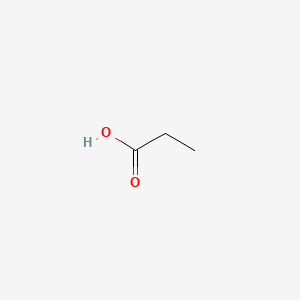
|
propionic acid |
propionic acid is a lipid of Fatty Acyls (FA) class. Propionic acid is associated with abnormalities such as Epilepsy, Infection, Tuberculosis, Alkalosis and Ischemia. The involved functions are known as Uptake, Biosynthetic Pathways, Methylation, Protein Overexpression and Biochemical Pathway. Propionic acid often locates in Body tissue, Cytoplasmic matrix, Membrane, Protoplasm and Extracellular. The associated genes with propionic acid are TRIO gene, TRRAP gene, SLC5A8 gene, SLC33A1 gene and Homologous Gene. The related lipids are Fatty Acids, Propionate, butyrate, Valerates and mycocerosic acid. |
7360 |

|
rotenone |
rotenone is a lipid of Polyketides (PK) class. Rotenone is associated with abnormalities such as Parkinson Disease, MYOPATHY, DISTAL, WITH ANTERIOR TIBIAL ONSET, Neurodegenerative Disorders, Septicemia and Respiratory Failure. The involved functions are known as Phosphorylation, Process, Cell Death, proteasome activity and Apoptosis. Rotenone often locates in Protoplasm, Presynaptic Terminals, Neurites, NADH dehydrogenase complex and Mitochondria. The associated genes with rotenone are DNAJB9 gene, EIF2S3 gene, Candidate Disease Gene, G-substrate and ERN1 gene. The related lipids are Lipopolysaccharides, Membrane Lipids, Phosphatidylserines, Fatty Acids and Cardiolipins. The related experimental models are Knock-out, Mouse Model, Disease model and Rodent Model. |
7079 |

|
oxytetracycline |
oxytetracycline is a lipid of Polyketides (PK) class. Oxytetracycline is associated with abnormalities such as Infection, X-linked centronuclear myopathy, Bacterial Infections, Heart failure and Onchocerciasis. The involved functions are known as Anabolism, physiological aspects, Transcription, Genetic, Fermentation and Transcriptional Activation. Oxytetracycline often locates in Chromosomes, Flank (surface region), Entire bony skeleton, Bone Marrow and Body tissue. The associated genes with oxytetracycline are Polypeptides, Homologous Gene, Gene Clusters, Locus and CYCS gene. The related lipids are LH 1 and Lipid Peroxides. The related experimental models are Disease model. |
6787 |

|
(-)-Epigallocatechin gallate |
(-)-Epigallocatechin gallate is a lipid of Polyketides (PK) class. (-)-epigallocatechin gallate is associated with abnormalities such as IMMUNE SUPPRESSION, Infection, Nodule, Lymphopenia and Tumor Immunity. The involved functions are known as Apoptosis, Cellular Immune Response, Specific immune response, Signal and Infiltration. (-)-epigallocatechin gallate often locates in Immune system, Cytoplasmic Granules, Skin, Protoplasm and Body tissue. The associated genes with (-)-Epigallocatechin gallate are C8orf4 gene, Genes, vpr, MAPK8 gene, P4HTM gene and GAG Gene. The related lipids are Promega, Lipopolysaccharides, Palmitates, Fatty Acids and Sphingolipids. The related experimental models are Mouse Model, Xenograft Model, Transgenic Model, Experimental Autoimmune Encephalomyelitis and Arthritis, Collagen-Induced. |
6551 |

|
PGD2 |
Pgd2 is a lipid of Fatty Acyls (FA) class. Pgd2 is associated with abnormalities such as Inflammatory disorder, Pleurisy, Rhinitis, Dehydration and Pneumonia. The involved functions are known as antagonists, fat cell differentiation, Phosphorylation, Process and Gene Expression. Pgd2 often locates in Cell surface, Body tissue, Extracellular, Bone Marrow and Membrane. The associated genes with PGD2 are oxytocin, 1-desamino-(O-Et-Tyr)(2)-, P4HTM gene, PTGS2 gene, PTGDS gene and IL3 gene. The related lipids are 15-deoxyprostaglandin J2, Nonesterified Fatty Acids, Lipopolysaccharides, Steroids and Liposomes. The related experimental models are Knock-out and Rodent Model. |
6464 |
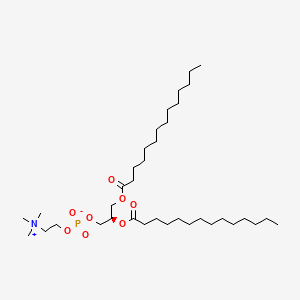
|
18194-24-6 |
18194-24-6 is a lipid of Glycerophospholipids (GP) class. 18194-24-6 is associated with abnormalities such as Cerebrovascular accident, Renal tubular disorder, Atherosclerosis, Hyperlipoproteinemia Type III and Lipid Metabolism Disorders. The involved functions are known as Process, protein folding, Catalyst, Biochemical Pathway and Fold in Medical Device Material. 18194-24-6 often locates in Tissue membrane, Membrane, periplasm, vesicle membrane and outer membrane. The associated genes with 18194-24-6 are Integral Membrane Proteins, Protein Structure, RTN4 gene, RTN4R gene and Protein, Organized by Structure. The related lipids are Micelles, dimyristoylphosphatidylglycerol, 1,2-dihexadecyl-sn-glycero-3-phosphocholine, Unilamellar Vesicles and cholesteryl oleate. The related experimental models are Mouse Model, Arthritis, Adjuvant-Induced, Disease model and Xenograft Model. |
6350 |
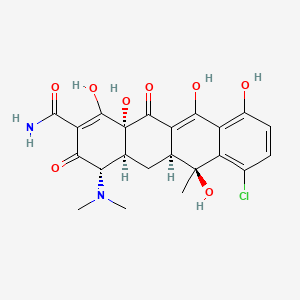
|
chlortetracycline |
chlortetracycline is a lipid of Polyketides (PK) class. Chlortetracycline is associated with abnormalities such as Granulomatous Disease, Chronic, Infection, Ischemia, Cerebral Ischemia and Cerebral Infarction. The involved functions are known as Regulation, Binding (Molecular Function), Agent, Stimulus and Process. Chlortetracycline often locates in Protoplasm, Plasma membrane, Membrane, Cytoplasm and specific granule. The associated genes with chlortetracycline are FPR1 gene, P4HTM gene, Homologous Gene, HIST1H1C gene and Microbiome. The related lipids are Lysophosphatidylcholines, Sterols, dilauroyl lecithin, seminolipid and Total cholesterol. The related experimental models are Mouse Model. |
6144 |

|
HEMATOXYLIN |
HEMATOXYLIN is a lipid of Polyketides (PK) class. Hematoxylin is associated with abnormalities such as Eosinophilia, Duodenal Adenoma, Senile Plaques, Morphologically altered structure and Cervical abscess. The involved functions are known as Uptake, Apoptosis, Amplification, Necrosis and Karyopyknosis. Hematoxylin often locates in Body tissue, Extracellular, Compact bone, Skin and Basement membrane. The associated genes with HEMATOXYLIN are GAPDH gene, Genome, Elastin, MERTK wt Allele and P4HTM gene. |
6127 |

|
EPA |
Epa is a lipid of Fatty Acyls (FA) class. |
5952 |
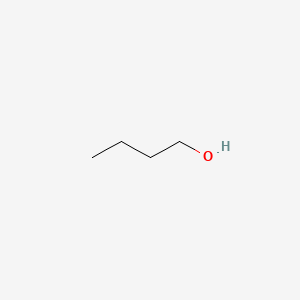
|
1-butanol |
1-butanol is a lipid of Fatty Acyls (FA) class. |
5925 |
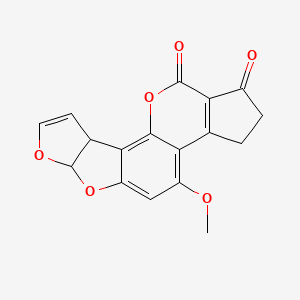
|
AFBI |
AFBI is a lipid of Polyketides (PK) class. Afbi is associated with abnormalities such as Pyotraumatic dermatitis, Infection, Hepatitis, Liver diseases and Hepatitis B. The involved functions are known as Immune response, Mutation, Anabolism, Metabolic Inhibition and Increased Sensitivy. Afbi often locates in Body tissue, Hepatic, Cytoplasm, Blood and Micronucleus. The associated genes with AFBI are TP53 gene, Genome, Transgenes, FATE1 gene and MANEA gene. The related lipids are Lipopolysaccharides, Lipid Peroxides, 1-(2-cyano-3,12-dioxooleana-1,9-dien-28-oyl) imidazole and Liposomes. |
5774 |

|
Linoleic acid |
Linoleic acid is a lipid of Fatty Acyls (FA) class. Linoleic acid is associated with abnormalities such as Diabetes Mellitus, Non-Insulin-Dependent, Metabolic syndrome, Obesity, Chronic Obstructive Airway Disease and Pneumonia. The involved functions are known as Insulin Resistance, Inflammation, Synthesis, Pathological accumulation of air in tissues and cytokine biosynthesis. The associated genes with Linoleic acid are TNF gene, CCL2 gene and TLR4 gene. The related lipids are palmitoleic acid, nervonic acid and Sphingolipids. |
5699 |

|
4-hydroxynonenal |
4-hydroxynonenal is a lipid of Fatty Acyls (FA) class. 4-hydroxynonenal is associated with abnormalities such as Chronic disease, Obesity, Diabetes, Acquired Immunodeficiency Syndrome and Lung diseases. The involved functions are known as protein expression, Glycolysis, mRNA Expression, Regulation and Mitochondrion in division. 4-hydroxynonenal often locates in Muscle, Mitochondria, Adipose tissue, Head and Mouse Muscle. The associated genes with 4-hydroxynonenal are STAT3 gene, SIRT1 gene, PGC gene, IL6 gene and cytochrome c''. The related lipids are Lipopolysaccharides, Lipid Peroxides, Promega, Membrane Lipids and oxidized lipid. The related experimental models are Mouse Model, Knock-out, Transgenic Model, Disease model and Rodent Model. |
5685 |

|
trichostatin A |
Trichostatin is a lipid of Polyketides (PK) class. Trichostatin is associated with abnormalities such as Dentatorubral-Pallidoluysian Atrophy, PARAGANGLIOMAS 3, abnormal fragmented structure, Disintegration (morphologic abnormality) and Hyperostosis, Diffuse Idiopathic Skeletal. The involved functions are known as Acetylation, Cell Differentiation process, histone modification, Gene Silencing and Transcriptional Activation. Trichostatin often locates in CD41a, Hematopoietic System, Chromatin Structure, Blood and Endothelium. The associated genes with Trichostatin are SPI1 gene, CELL Gene, Chromatin, CXCR4 gene and DNMT1 gene. The related lipids are Butyrates, Promega, butyrate, Lipopolysaccharides and Steroids. The related experimental models are Knock-out, Mouse Model, Xenograft Model and Cancer Model. |
5401 |

|
quercetin |
quercetin is a lipid of Polyketides (PK) class. Quercetin is associated with abnormalities such as Coronary heart disease, Myocardial Infarction, Cirrhosis, Coronary Arteriosclerosis and Vascular ring. The involved functions are known as Vasodilation, physiological aspects, Fermentation, Process and Ingredient. Quercetin often locates in Arterial system, Endothelium, Skin, Endothelium, Vascular and Tissue specimen. The associated genes with quercetin are P4HTM gene, SULT gene, UGT1A1 gene, ARHGAP26 gene and PLXNB1 gene. The related lipids are blood lipid, Promega, Steroids, Phosphatidylserines and Fatty Acids. The related experimental models are Knock-out, Mouse Model, Xenograft Model, Tissue Model and Cancer Model. |
5377 |

|
nystatin |
nystatin is a lipid of Polyketides (PK) class. Nystatin is associated with abnormalities such as Virus Diseases, Infection, Candidiasis, Leukopenia and Mycoses. The involved functions are known as Membrane Potentials, Uptake, Flow or discharge, Cell membrane potential and adenine transport. Nystatin often locates in Cell Wall, Plasma membrane, Extracellular, Membrane and Virion. The associated genes with nystatin are Genome, Integral Membrane Proteins, Amino Acids, Basic, P4HTM gene and Homologous Gene. The related lipids are Sterols, Liposomes, Membrane Lipids, Sphingolipids and 1,2-oleoylphosphatidylcholine. The related experimental models are Knock-out and Xenograft Model. |
4890 |
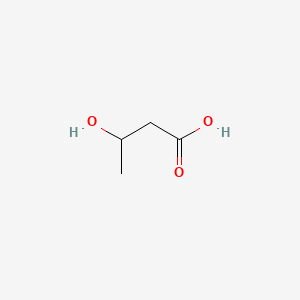
|
3-hydroxybutyric acid |
3-hydroxybutyric acid is a lipid of Fatty Acyls (FA) class. 3-hydroxybutyric acid is associated with abnormalities such as Ketosis. The involved functions are known as fatty acid oxidation, Oxidation, Synthesis, inhibitors and glucose metabolism. 3-hydroxybutyric acid often locates in Blood, Adipose tissue, Protoplasm, Hepatic and Extracellular. The associated genes with 3-hydroxybutyric acid are Genes, Developmental and Oncogene, RET. The related lipids are Fatty Acids, Nonesterified, 6-hydroxyhexanoate, tributyrin, 3-Hydroxyvalerate and Valerates. |
4735 |
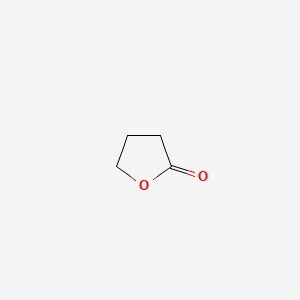
|
Gamma-butyrolactone |
Gamma-butyrolactone is a lipid of Fatty Acyls (FA) class. |
4604 |

|
daidzein |
daidzein is a lipid of Polyketides (PK) class. Daidzein is associated with abnormalities such as Cardiovascular Diseases, Osteoporosis, Heart Diseases, Thyroid Diseases and Exanthema. The involved functions are known as Cell Growth, Disease Progression, metaplastic cell transformation, Cell Cycle and M Phase Cell Cycle Arrest. Daidzein often locates in Urothelium, Mucous Membrane, Chromosomes, Epithelium and Ribosomes. The associated genes with daidzein are Tumor Suppressor Genes, Genome, TIRAP gene, TICAM2 gene and Candidate Disease Gene. The related lipids are Promega, Steroids, Saponins, enterodiol and linoleates. The related experimental models are Xenograft Model, Knock-out, Mouse Model, Breast Cancer Model and Arthritis, Experimental. |
4463 |

|
apigenin |
apigenin is a lipid of Polyketides (PK) class. Apigenin is associated with abnormalities such as Morphologically altered structure, Chimera disorder, Hypertensive disease, infection induced and Infection. The involved functions are known as inhibitors, Gene Expression, Process, Metabolic Inhibition and Cell Death. Apigenin often locates in Vacuole, Cytoplasmic matrix, Cytoplasm, Tissue membrane and Membrane. The associated genes with apigenin are MSMP gene, BCL2 gene, PTGS2 gene, Chromatin and SLC33A1 gene. The related lipids are Lipopolysaccharides, Steroids, 1-Butanol, agosterol A and Butyrates. The related experimental models are Mouse Model, Tissue Model, Knock-out, Xenograft Model and Disease model. |
4250 |

|
alpha-linolenic acid |
Alpha-linolenic acid is a lipid of Fatty Acyls (FA) class. Alpha-linolenic acid is associated with abnormalities such as Coronary heart disease, abnormal fragmented structure, Arterial thrombosis and Subarachnoid Hemorrhage. The involved functions are known as Anabolism, Signal, Transcription, Genetic, Saturated and Regulation. Alpha-linolenic acid often locates in Blood, Body tissue, Plasma membrane, Hepatic and peroxisome. The associated genes with alpha-linolenic acid are FATE1 gene, volicitin, CYP2U1 gene, CYP1A2 gene and CYP2J2 gene. The related lipids are Fatty Acids, Dietary Fatty Acid, stearidonic acid and Fatty Acids, Nonesterified. |
4231 |
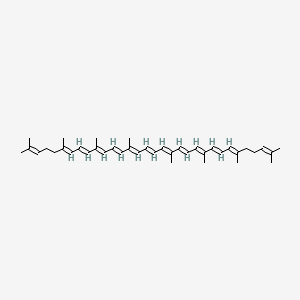
|
Lycopene |
Lycopene is a lipid of Prenol Lipids (PR) class. Lycopene is associated with abnormalities such as Consumption-archaic term for TB, Chronic disease, Dehydration, furuncle and Cardiovascular Diseases. The involved functions are known as Cell Differentiation process, Signal Transduction, Biochemical Pathway, Mutation and IGF-1 Signaling Pathway. Lycopene often locates in Body tissue, Hepatic, Blood, Adipose tissue and Structure of parenchyma of lung. The associated genes with Lycopene are EPB41L2 gene, VEGFB gene, P4HTM gene, FATE1 gene and SLC33A1 gene. The related lipids are Micelles, Liposomes, Total cholesterol, Steroids and apo-10'-lycopenoic acid. The related experimental models are Mouse Model, Knock-out, Cancer Model, Transgenic Model and Xenograft Model. |
3986 |

|
6-aminohexanoic acid |
6-aminohexanoic acid is a lipid of Fatty Acyls (FA) class. 6-aminohexanoic acid is associated with abnormalities such as Blood Clot, Myocardial Infarction, Cerebrovascular accident, Renal impairment and Scoliosis, unspecified. The involved functions are known as Fibrinolysis, Agent, Hemorrhage, plasminogen activation and inhibitors. 6-aminohexanoic acid often locates in Chest, Blood, Body tissue, peritoneal and Plasma membrane. The associated genes with 6-aminohexanoic acid are P4HTM gene, BSND gene, MTPN gene, NDUFS4 gene and Homologous Gene. The related lipids are Phosphatidylserines and Butyric Acid. |
3685 |
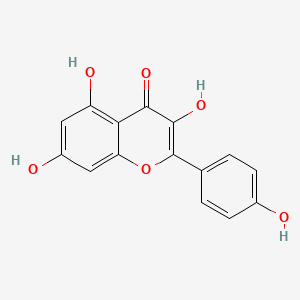
|
kaempferol |
kaempferol is a lipid of Polyketides (PK) class. Kaempferol is associated with abnormalities such as Cardiovascular Diseases, IMMUNE SUPPRESSION, Inflammatory disorder, Dermatitis, Atopic and Asthma. The involved functions are known as enzyme activity, antagonists, DNA Binding, Anabolism and Transcription, Genetic. Kaempferol often locates in aryl hydrocarbon receptor complex, Cytoplasmic matrix, soluble, BL21 and Vacuole. The associated genes with kaempferol are CYP1A1 gene, AHR gene, Genes, Reporter, Candidate Disease Gene and Alleles. The related lipids are Fatty Acids, Steroids, Lipopolysaccharides, Total cholesterol and Palmitates. The related experimental models are Knock-out, Xenograft Model, Breast Cancer Model, Disease model and Animal Disease Models. |
3675 |
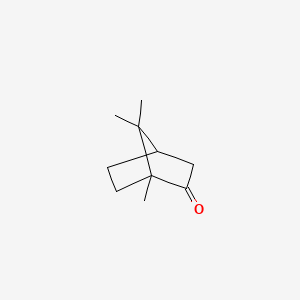
|
(+)-Camphor |
(+)-camphor is a lipid of Prenol Lipids (PR) class. (+)-camphor is associated with abnormalities such as Athetoid cerebral palsy. The involved functions are known as inhibitors, Synthesis, Feedback and Competitive inhibition. The associated genes with (+)-Camphor are 4S-limonene synthase. The related lipids are palmitoleic acid, pentadecanoic acid, stearic acid and erucic acid. |
3660 |

|
1-Oleoyl Lysophosphatidic Acid |
1-Oleoyl Lysophosphatidic Acid is a lipid of Glycerophospholipids (GP) class. 1-oleoyl lysophosphatidic acid is associated with abnormalities such as Myocardial Infarction, early pregnancy, Scleroderma, Blind Vision and Hyperlipidemia. The involved functions are known as Agent, Blood coagulation, Selection, Genetic, Analyte and Biological Processes. 1-oleoyl lysophosphatidic acid often locates in Tissue specimen, Body tissue, Blood, Membrane and Skin. The associated genes with 1-Oleoyl Lysophosphatidic Acid are Mucin-16, Peptides, SMAD4 gene, RND1 gene and Polypeptides. The related lipids are lysophosphatidic acid, A(2)C, Lysophospholipids, Fatty Acids and sphingosine 1-phosphate. The related experimental models are Mouse Model, Knock-out, Cancer Model, Xenograft Model and Arthritis, Adjuvant-Induced. |
3463 |

|
luteolin |
luteolin is a lipid of Polyketides (PK) class. Luteolin is associated with abnormalities such as Morphologically altered structure, Nodule, retinal toxicity, CLEFT LIP, CONGENITAL HEALED and Ischemia. The involved functions are known as Metabolic Inhibition, Cell Death, Caspase Activation, activation of protein kinase C activity by G-protein coupled receptor protein signaling pathway and protein kinase C activity. Luteolin often locates in Mitochondria, Cell-Free System, Protoplasm, Membrane and Body tissue. The associated genes with luteolin are BCL2 gene, TNFSF10 gene, BCL2L1 gene, XIAP gene and MCL1 gene. The related lipids are Lipopolysaccharides, Sterols, blood lipid, Fatty Acids and Steroids. The related experimental models are Xenograft Model, Mouse Model, Experimental Autoimmune Encephalomyelitis, Knock-out and Cancer Model. |
3284 |

|
(r)-3-hydroxybutanoic acid |
(r)-3-hydroxybutanoic acid is a lipid of Fatty Acyls (FA) class. |
2710 |

|
ZEARALENONE |
ZEARALENONE is a lipid of Polyketides (PK) class. Zearalenone is associated with abnormalities such as HYPOTRICHOSIS, LOCALIZED, AUTOSOMAL RECESSIVE, 2, Estrogen excess, Food-Drug Interactions, Osteomalacia and Osteoporosis. The involved functions are known as mRNA Expression, Metabolic Inhibition, Phosphorylation, Agent and Transcriptional Activation. Zearalenone often locates in Gastrointestinal tract structure, soluble, viral nucleocapsid location, Spindle and Hepatic. The associated genes with ZEARALENONE are Candidate Disease Gene, Genome, Genes, Reporter, P4HTM gene and Open Reading Frames. The related lipids are Lipopolysaccharides, Steroids, Fatty Acids and Promega. The related experimental models are Transgenic Model. |
2573 |

|
Gossypol |
Gossypol is a lipid of Prenol Lipids (PR) class. Gossypol is associated with abnormalities such as Paralytic Ileus, PARKINSON DISEASE, LATE-ONSET, Fibrillation, Hepatic necrosis and Lymphopenia. The involved functions are known as Atrophic, Ulcer, Necrosis, Apoptosis and antagonists. Gossypol often locates in Mucous Membrane, Epithelium, Blood, Microsomes, Liver and Autophagic vacuole. The associated genes with Gossypol are BCL2A1 gene, BCL2 gene, Transgenes, IGH@ gene cluster and Bax protein (53-86). The related lipids are Promega, proteoliposomes, Phosphatidylserines and Liposomes. The related experimental models are Transgenic Model and Xenograft Model. |
2557 |
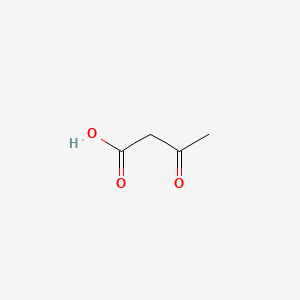
|
Acetoacetic acid |
Acetoacetic acid is a lipid of Fatty Acyls (FA) class.Acetoacetic acid is associated with abnormalities such as Dehydration. The involved functions are known as Biochemical Reaction, intracellular signal transduction, fatty acid elongation, Cytokinesis and Mass-to-Charge Ratio. The associated genes with Acetoacetic acid are CFB gene and mersacidin. Acetoacetic acidis associated with Carbon, Acids, Potassium, Acetoacetic acid and Oximes. The related lipids are Nonesterified Fatty Acids and Stearates. |
2523 |
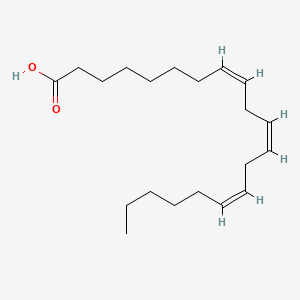
|
bishomo-gamma-linolenic acid |
Bishomo-gamma-linolenic acid is a lipid of Fatty Acyls (FA) class. Bishomo-gamma-linolenic acid is associated with abnormalities such as Diabetes, Obesity, Hypertensive disease, Cirrhosis and Hepatorenal Syndrome. The involved functions are known as Oxidation, Process, Metabolic Inhibition, epoxide hydrolase activity and Signal Transduction Pathways. Bishomo-gamma-linolenic acid often locates in Protoplasm, Cytoplasmic matrix, soluble, Membrane and Tissue membrane. The associated genes with bishomo-gamma-linolenic acid are P4HTM gene, IMPACT gene, arginine methyl ester, CYP gene and PTGS1 gene. The related lipids are Fatty Acids, 17-octadecynoic acid, Lipopolysaccharides, palmitoleic acid and nervonic acid. The related experimental models are Knock-out and Mouse Model. |
2467 |
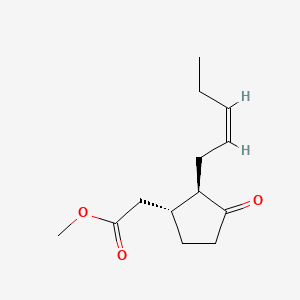
|
Methyl jasmonate |
Methyl jasmonate is a lipid of Fatty Acyls (FA) class. Methyl jasmonate is associated with abnormalities such as Infection, abnormal fragmented structure, Disintegration (morphologic abnormality), Parasitic Diseases and Contracture. The involved functions are known as Stimulus, Signal, Cell Death, Infiltration and Mutation. Methyl jasmonate often locates in Extracellular, Plasma membrane, Cytoplasm, Cell Wall and Body tissue. The associated genes with Methyl jasmonate are Polypeptides, Homologous Gene, NPR1 gene, systemin and Locus. The related lipids are Fatty Acids, Saponins and Oxylipins. |
2442 |

|
naringenin |
naringenin is a lipid of Polyketides (PK) class. Naringenin is associated with abnormalities such as Dehydration, Papillon-Lefevre Disease, BOSLEY-SALIH-ALORAINY SYNDROME, Cardiovascular Diseases and Atherosclerosis. The involved functions are known as Pigmentation, Biosynthetic Pathways, metaplastic cell transformation, 4-coumarate-CoA ligase activity and Pigment. Naringenin often locates in Body tissue, Cell Wall, Membrane, Cytoplasmic matrix and Tissue membrane. The associated genes with naringenin are Genome, Genes, Regulator, Alleles, Homologous Gene and SPEN gene. The related lipids are Fatty Acids, Total cholesterol, Lipopolysaccharides, Oleates and Cholesterol, Dietary. The related experimental models are Knock-out and Mouse Model. |
2420 |
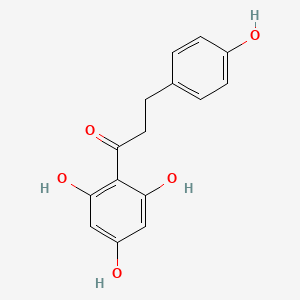
|
phloretin |
phloretin is a lipid of Polyketides (PK) class. Phloretin is associated with abnormalities such as Atherosclerosis, Diabetes Mellitus, Non-Insulin-Dependent, Alkalemia, Renal tubular disorder and pathologic fistula. The involved functions are known as Anabolism, glycosyltransferase activity, Biosynthetic Pathways, Localized desquamation and Biological Processes. Phloretin often locates in soluble, BL21, Cytoplasmic, Extracellular and Cytoplasm. The associated genes with phloretin are Homologous Gene, CD36 gene, Candidate Disease Gene, SLC33A1 gene and PAK1IP1 gene. The related lipids are Liposomes, Palmitates, Fatty Acids, Sterols and 6-ketocholestanol. The related experimental models are Knock-out. |
2367 |
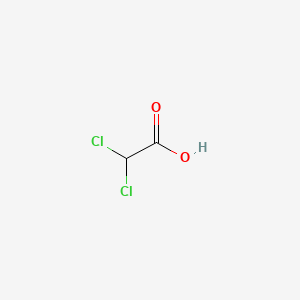
|
Dichloroacetic acid |
Dichloroacetic acid is a lipid of Fatty Acyls (FA) class. Dichloroacetic acid is associated with abnormalities such as Acidosis, Lactic, Metabolic Diseases, CLEFT LIP, CONGENITAL HEALED, Asthma and hyperthyroid. The involved functions are known as inhibitors, Chlorination, Metabolic Inhibition, Process and Sterility. Dichloroacetic acid often locates in Intestine - Large Intestine - Cecum (MMHCC), Mouse Liver, Back and Head. The associated genes with Dichloroacetic acid are GSTZ1 gene, PSMA5 gene and Maleylacetoacetate isomerase. The related lipids are Nonesterified Fatty Acids. |
2361 |
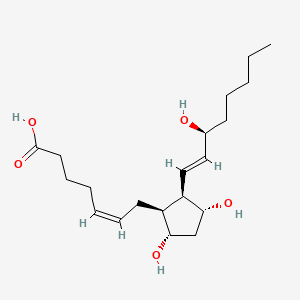
|
15-F2t-IsoP |
15-f2t-isop is a lipid of Fatty Acyls (FA) class. 15-f2t-isop is associated with abnormalities such as Diabetes Mellitus, Acute coronary syndrome, Risk factor, cardiovascular, thrombocytosis and Chronic ischemic heart disease NOS. The involved functions are known as Anabolism, Inflammation, Lipid Peroxidation, Excretory function and Platelet Activation. The associated genes with 15-F2t-IsoP are PTGS2 gene. |
2120 |

|
FLAVONE |
FLAVONE is a lipid of Polyketides (PK) class. Flavone is associated with abnormalities such as Cardiovascular Diseases, Cerebrovascular accident, DERMATITIS HERPETIFORMIS, FAMILIAL, Hyperinsulinism and Inflammatory disorder. The involved functions are known as Oxidation-Reduction, Metabolic Inhibition, Inflammation, Phosphorylation and antioxidant activity. Flavone often locates in Endothelium, Hepatic, Protoplasm, Body tissue and Extracellular. The associated genes with FLAVONE are ICAM1 gene, BCL2L1 gene, MYC gene, TP53 gene and cytochrome c''. The related lipids are Promega, Steroids and Total cholesterol. The related experimental models are Knock-out, Disease model and Animal Disease Models. |
2093 |
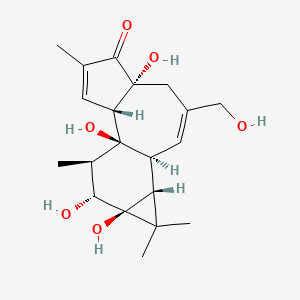
|
Phorbol |
Phorbol is a lipid of Prenol Lipids (PR) class. Phorbol is associated with abnormalities such as furuncle, Infection, endothelial dysfunction, Morphologically altered structure and Acute erythroleukemia. The involved functions are known as Tyrosine Phosphorylation, Metabolic Inhibition, Transcription, Genetic, Protein Biosynthesis and Signal. Phorbol often locates in Tissue membrane, Membrane, Cell surface, soluble and Cytoplasmic Domain. The associated genes with Phorbol are STAT3 gene, JAK2 gene, JUN gene, PROC gene and MAPK8 gene. The related lipids are Lipopolysaccharides, Phosphatidylserines, Liposomes, Fatty Acids and Octanols. |
2082 |

|
Sphingosine 1-phosphate |
Sphingosine 1-phosphate is a lipid of Sphingolipids (SP) class. Sphingosine 1-phosphate is associated with abnormalities such as Infection, Painful Bladder Syndrome, Atherosclerosis, Hyperglycemia and Rheumatoid Arthritis. The involved functions are known as Phosphorylation, Regulation, enzyme activity, Energy Absorption and Vascular Permeability. Sphingosine 1-phosphate often locates in Endothelium, Tissue membrane, Vascular System, Protoplasm and Microfilaments. The associated genes with Sphingosine 1-phosphate are MBTPS1 gene, FBXL15 gene, TEK gene, NTRK1 gene and Gene Family. The related lipids are Promega, Lipopolysaccharides, lysophosphatidic acid, Lysophosphatidylcholines and Lysophospholipids. The related experimental models are Knock-out, Mouse Model, Transgenic Model, Disease model and Experimental Autoimmune Encephalomyelitis. |
2005 |

|
baicalein |
baicalein is a lipid of Polyketides (PK) class. Baicalein is associated with abnormalities such as Neurodegenerative Disorders, Fibrillation, Hypertensive disease, Aortic coarctation and Coronary Occlusion. The involved functions are known as Anabolism, Polymerization, Process, inhibitors and Pathogenesis. Baicalein often locates in Membrane, Lipid Bilayers, soluble, Cell-Free System and Protoplasm. The associated genes with baicalein are P4HTM gene, BIRC5 gene, TSPO gene, SHOC2 gene and XIAP gene. The related lipids are Fatty Acids, Nonesterified Fatty Acids, iodoresiniferatoxin, Lipopolysaccharides and 17-octadecynoic acid. The related experimental models are Knock-out, Mouse Model and Parkinsonism, Experimental. |
1997 |
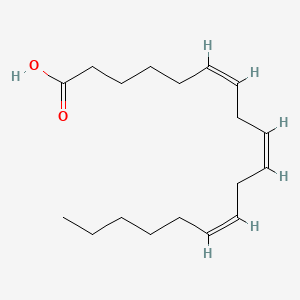
|
gamma-Linolenic acid |
Gamma-linolenic acid is a lipid of Fatty Acyls (FA) class. The involved functions are known as Drug Interactions. Gamma-linolenic acid often locates in Articular system. |
1919 |
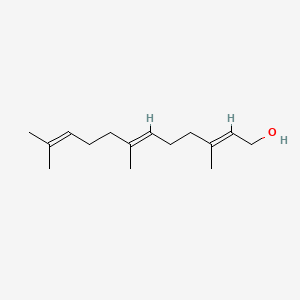
|
2E,6E-farnesol |
2e,6e-farnesol is a lipid of Prenol Lipids (PR) class. 2e,6e-farnesol is associated with abnormalities such as Granulomatous Disease, Chronic, pathologic fistula and Cavitation. The involved functions are known as Regulation, Metabolic Inhibition, cholesterol biosynthetic process, Process and Transcription, Genetic. 2e,6e-farnesol often locates in Plasma membrane, Cytoplasmic matrix, cornified envelope, Epidermis and peroxisome. The associated genes with 2E,6E-farnesol are RAB3A gene, FOSL1 gene, CASP8AP2 gene, RCC1 gene and GALE gene. The related lipids are Sterols, Membrane Lipids and Steroids. |
1905 |
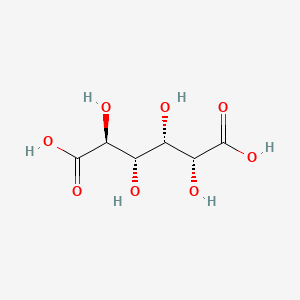
|
Glucaric acid |
Glucaric acid is a lipid of Fatty Acyls (FA) class. Glucaric acid is associated with abnormalities such as Consumption-archaic term for TB and furuncle. The involved functions are known as Oxidation, Mutation, Process, Cell Growth and Anabolism. Glucaric acid often locates in BL21, Clone and host. The associated genes with Glucaric acid are MIOX gene, ISYNA1 gene, Genome and Candidate Disease Gene. The related experimental models are Knock-out. |
1814 |
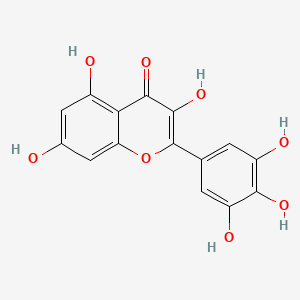
|
myricetin |
myricetin is a lipid of Polyketides (PK) class. Myricetin is associated with abnormalities such as Diabetes, First myocardial infarction, Diabetes Mellitus, Non-Insulin-Dependent, Asthma and Cataract. The involved functions are known as Cell Survival, inhibitors, Process, Metabolic Inhibition and Oxidation. Myricetin often locates in Fibril - cell component, soluble, Body tissue, Back and Tissue membrane. The associated genes with myricetin are HPGDS gene, P4HTM gene, CFLAR gene, SLC2A2 gene and SLC2A1 gene. The related lipids are Promega, Sterols, dipalmitoylphosphatidylserine, 1,2-oleoylphosphatidylcholine and Membrane Lipids. |
1801 |

|
(e,e,e,e)-squalene |
(e,e,e,e)-squalene is a lipid of Fatty Acyls (FA) class. (e,e,e,e)-squalene is associated with abnormalities such as Hypercholesterolemia and Cataract. The involved functions are known as Process, metaplastic cell transformation, Protein Overexpression, Anabolism and Biosynthetic Pathways. (e,e,e,e)-squalene often locates in Membrane, Protoplasm, Plasma membrane, Tissue membrane and Back. The associated genes with (e,e,e,e)-squalene are Genome, IMPACT gene, GAPDH gene, GTF2I gene and Chromatin. The related lipids are Membrane Lipids, cycloartenol, Sterols, Fatty Acids and Nonesterified Fatty Acids. |
1766 |
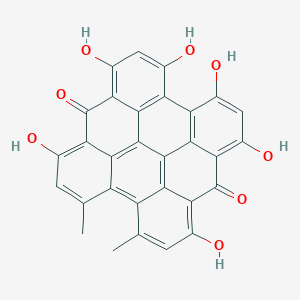
|
hypericin |
hypericin is a lipid of Polyketides (PK) class. Hypericin is associated with abnormalities such as Dermatitis, Phototoxic, Dehydration, Photosensitization, Morphologically altered structure and Myocardial Infarction. The involved functions are known as Cell Cycle Checkpoints, Apoptosis, Acetylation, Cell Survival and Caspase Activation. Hypericin often locates in insoluble fraction, Cytoplasmic matrix, Protoplasm, Tissue membrane and Cytoplasm. The associated genes with hypericin are CDC37 gene, HSPA8 gene, RAF1 gene, cyclin H and FK228. The related lipids are Phosphatidylserines. |
1752 |

|
emodin |
emodin is a lipid of Polyketides (PK) class. Emodin is associated with abnormalities such as Infection, Conjunctivitis, Vernal, Stevens-Johnson Syndrome, Conjunctival scar and Allergic Conjunctivitis. The involved functions are known as signaling cascade, Metabolic Inhibition, Cell Death, Phosphorylation and JNK Pathway. Emodin often locates in Membrane, Protoplasm, Mitochondria, Cytoplasmic matrix and soluble. The associated genes with emodin are cytochrome c'', UTS2 gene, TK Gene, Gene Clusters and CFC1 gene. The related lipids are Phosphatidylserines, Promega, Sphingolipids, Membrane Lipids and Palmitates. The related experimental models are Mouse Model and Transgenic Model. |
1742 |

|
hesperidin |
(2S)-5-hydroxy-2-(3-hydroxy-4-methoxyphenyl)-4-oxo-3,4-dihydro-2H-chromen-7-yl 6-O-(6-deoxyhexopyranosyl)hexopyranoside is a lipid of Polyketides (PK) class. (2s)-5-hydroxy-2-(3-hydroxy-4-methoxyphenyl)-4-oxo-3,4-dihydro-2h-chromen-7-yl 6-o-(6-deoxyhexopyranosyl)hexopyranoside is associated with abnormalities such as Osteoporosis, Postmenopausal, estrogen deficiency, Chronic venous insufficiency, Neurodegenerative Disorders and Cerebrovascular accident. The involved functions are known as Sweetening Agents, Vmax, enzyme activity, Fermentation and Regulation. (2s)-5-hydroxy-2-(3-hydroxy-4-methoxyphenyl)-4-oxo-3,4-dihydro-2h-chromen-7-yl 6-o-(6-deoxyhexopyranosyl)hexopyranoside often locates in Entire gastrointestinal tract, soluble, Entire bony skeleton, Trabecular substance of bone and Blood. The associated genes with (2S)-5-hydroxy-2-(3-hydroxy-4-methoxyphenyl)-4-oxo-3,4-dihydro-2H-chromen-7-yl 6-O-(6-deoxyhexopyranosyl)hexopyranoside are MTPN gene, GLUCOSIDASE, STN gene, SLC33A1 gene and GHRL gene. The related lipids are Total cholesterol and blood lipid. The related experimental models are Arthritis, Collagen-Induced. |
1455 |
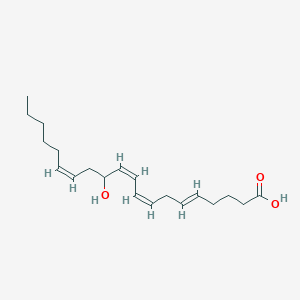
|
12-hete |
12-hete is a lipid of Fatty Acyls (FA) class. |
1452 |
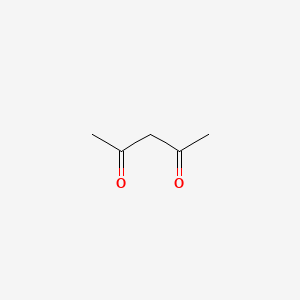
|
2,4-pentanedione |
2,4-pentanedione is a lipid of Fatty Acyls (FA) class. The related lipids are Butyrates. |
1440 |
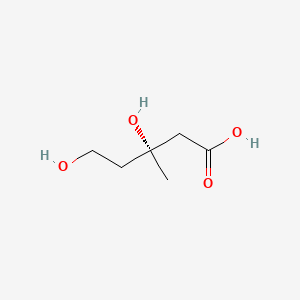
|
Mevalonic acid |
Mevalonic acid is a lipid of Fatty Acyls (FA) class. |
1437 |

|
SCHEMBL105486 |
Kakonein is a lipid of Polyketides (PK) class. Kakonein is associated with abnormalities such as Fatty Liver, Chronic liver disease, Morphologically altered structure, Hypertensive disease and Cardiovascular Diseases. The involved functions are known as protein expression, Extravasation, Liver damage, mRNA Expression and cell activation. Kakonein often locates in Body tissue, Hepatic, Microvilli, Cytoplasm and Membrane. The associated genes with Kakonein are TJP1 gene, CD14 gene, iberiotoxin, AT-Rich Interactive Domain-Containing Protein 1A and NKS1 gene. The related lipids are dehydrosoyasaponin I and Steroids. The related experimental models are Knock-out. |
1391 |
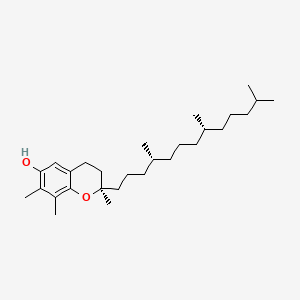
|
gamma-tocopherol |
Gamma-tocopherol is a lipid of Prenol Lipids (PR) class. The involved functions are known as 5-(carboxyamino)imidazole ribonucleotide mutase activity, Adverse effects, Longterm Effects, Luteal Phase and Drug Interactions. Gamma-tocopherol often locates in Blood. The related lipids are Total cholesterol. |
1377 |

|
(-)-Epigallocatechin |
(-)-Epigallocatechin is a lipid of Polyketides (PK) class. The involved functions are known as Protective Agents, inhibitors, Process, Drug Kinetics and Fermentation. (-)-epigallocatechin often locates in Hepatic, Blood, Membrane, Back and apical membrane. The associated genes with (-)-Epigallocatechin are ADRBK1 gene and FASTK Gene. The related lipids are 1,2-dilinolenoyl-3-(4-aminobutyryl)propane-1,2,3-triol. The related experimental models are Rodent Model and Transgenic Model. |
1282 |
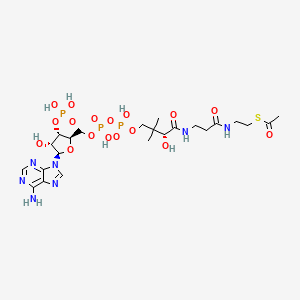
|
Acetyl-coa |
|
1243 |
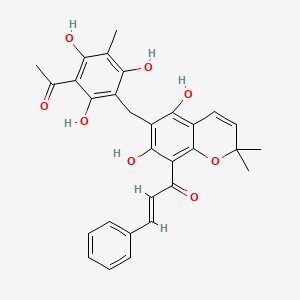
|
rottlerin |
Rottlerin is a lipid of Polyketides (PK) class. Rottlerin is associated with abnormalities such as PARAGANGLIOMAS 2, Hyperostosis, Diffuse Idiopathic Skeletal, Virus Diseases, Perisylvian syndrome and Autoimmune disease (systemic) NOS. The involved functions are known as Apoptosis, Regulation, Signal Transduction, inhibitors and Proteasome Inhibitors [MoA]. Rottlerin often locates in Clone, Membrane, Body tissue, Plasma membrane and soluble. The associated genes with Rottlerin are XIAP gene, GAPDH gene, ICAM1 gene, P4HTM gene and TNFSF10 gene. The related lipids are Promega, Fatty Acids, Sphingolipids, Lipopolysaccharides and Saponin. The related experimental models are Mouse Model, Xenograft Model and Cancer Model. |
1198 |
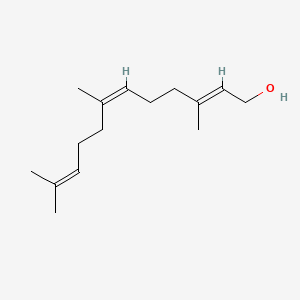
|
(e,z)-farnesol |
(e,z)-farnesol is a lipid of Prenol Lipids (PR) class. |
1183 |
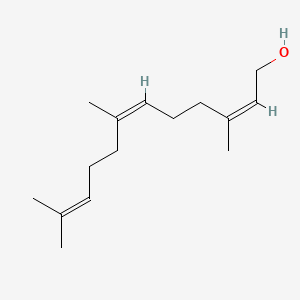
|
(z,z)-farnesol |
(z,z)-farnesol is a lipid of Prenol Lipids (PR) class. |
1183 |
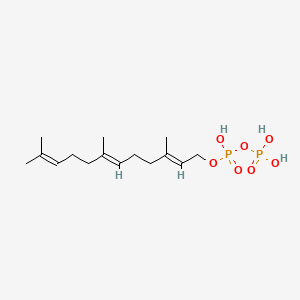
|
Farnesyl diphosphate |
Farnesyl diphosphate is a lipid of Prenol Lipids (PR) class. Farnesyl diphosphate is associated with abnormalities such as Dental caries and Hyperostosis, Diffuse Idiopathic Skeletal. The involved functions are known as Regulation, Process, Signal, Anabolism and inhibitors. Farnesyl diphosphate often locates in peroxisome, Cytoplasmic matrix, Plasma membrane, soluble and Mitochondria. The associated genes with Farnesyl diphosphate are HSD3B1 gene, ABRA gene, MATN1 gene, SEPSECS gene and MBD2 gene. The related lipids are Sterols, 22-hydroxycholesterol, dehydrosqualene, SK&F 104976 and 25-hydroxycholesterol. |
1181 |
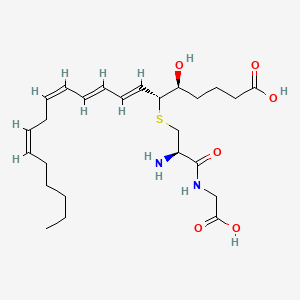
|
LTD4 |
Ltd4 is a lipid of Fatty Acyls (FA) class. Ltd4 is associated with abnormalities such as Inflammatory Bowel Diseases, Inflammatory disorder, Asthma, Pneumonia and Allergic asthma. The involved functions are known as inhibitors, Signal Transduction, Cell Survival, antagonists and Phosphorylation. Ltd4 often locates in Membrane, Tissue membrane, Protoplasm, Cytoplasmic matrix and membrane fraction. The associated genes with LTD4 are ALOX5 gene, UMOD gene, P4HTM gene, RAF1 gene and Homologous Gene. The related lipids are Lipopolysaccharides. |
1167 |
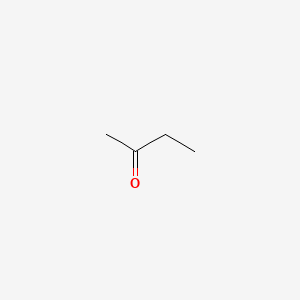
|
2-butanone |
2-butanone is a lipid of Fatty Acyls (FA) class. |
1159 |
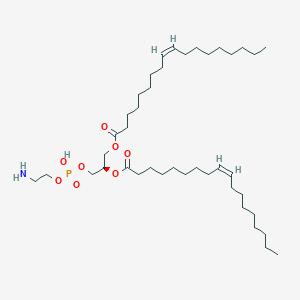
|
PE(18:1(9Z)/18:1(9Z)) |
PE(18:1(9Z)/18:1(9Z)) is a lipid of Glycerophospholipids (GP) class. Pe(18:1(9z)/18:1(9z)) is associated with abnormalities such as Respiratory Failure, Myopathy, Muscular Dystrophy, Duchenne, Autoimmune Lymphoproliferative Syndrome and Osteoporosis. The involved functions are known as establishment and maintenance of localization, Anabolism, Protein Biosynthesis, nuclear mRNA cis splicing, via spliceosome and Increased Sensitivy. Pe(18:1(9z)/18:1(9z)) often locates in Sarcolemma, Muscle, Membrane, viral nucleocapsid location and Tissue fiber. The associated genes with PE(18:1(9Z)/18:1(9Z)) are DMD gene, DUOXA1 gene, P4HTM gene, delta sleep-inducing peptide, N-Tyr- and Homologous Gene. The related lipids are Lipofectin, Liposomes, Pregnadienes, N-(1-(2,3-dioleyloxy)propyl)-N,N,N-trimethylammonium chloride and DOPE. |
1117 |
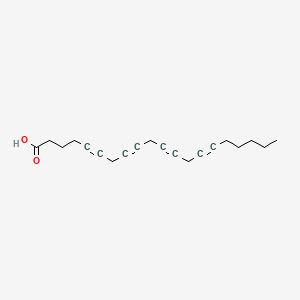
|
Etya |
Etya is a lipid of Fatty Acyls (FA) class. |
1028 |
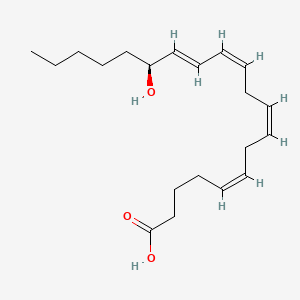
|
15S-HETE |
15s-hete is a lipid of Fatty Acyls (FA) class. 15s-hete is associated with abnormalities such as Ischemia and Vascular Diseases. The involved functions are known as Transcription, Genetic, Signal Transduction, tube formation, Angiogenic Process and Biochemical Pathway. 15s-hete often locates in Endothelium, Membrane, Cytoplasm, Body tissue and Protoplasm. The associated genes with 15S-HETE are RAC1 gene, ALOX15 gene, ALOX5 gene, Candidate Disease Gene and GAPDH gene. |
1011 |
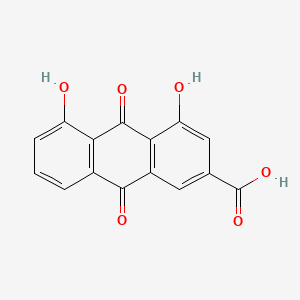
|
Rhein |
Rhein is a lipid of Polyketides (PK) class. Rhein is associated with abnormalities such as Obesity, Non-alcoholic Fatty Liver Disease, Dyslipidemias, Fatty Liver and Degenerative polyarthritis. The involved functions are known as Adipogenesis, Insulin Resistance, luciferase activity, Transcription, Genetic and Inflammation. Rhein often locates in Hepatic, Brown Fat, Muscle, Mouse Liver and Mitochondria. The associated genes with Rhein are QRSL1 gene, Candidate Disease Gene, CFB gene, STAT6 gene and GATA3 gene. The related lipids are Fatty Acids. |
986 |
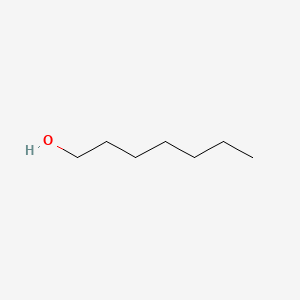
|
n-heptanol |
N-heptanol is a lipid of Fatty Acyls (FA) class. N-heptanol is associated with abnormalities such as Corneal Neovascularization. N-heptanol often locates in Epithelium and Structure of corneal epithelium. The related lipids are Heptanol. |
984 |
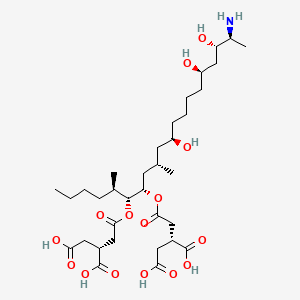
|
fumonisin b1 |
fumonisin b1 is a lipid of Sphingolipids (SP) class. Fumonisin b1 is associated with abnormalities such as Infection, Kidney Diseases, Liver diseases, DERMATITIS HERPETIFORMIS, FAMILIAL and Malnutrition. The involved functions are known as Gene Expression, Anabolism, Signal, Biosynthetic Pathways and Regulation. Fumonisin b1 often locates in Body tissue, Microsomes, microsomal membrane, Protoplasm and Mitochondria. The associated genes with fumonisin b1 are Genome, P4HTM gene, FATE1 gene, BCL2 gene and TMEM132D gene. The related lipids are dihydroceramide, ceramide 1-phosphate, Sphingolipids, Fatty Acids and Palmitates. |
902 |
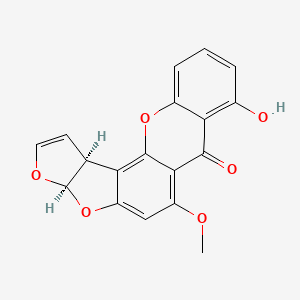
|
STERIGMATOCYSTIN |
STERIGMATOCYSTIN is a lipid of Polyketides (PK) class. Sterigmatocystin is associated with abnormalities such as CLEFT LIP, CONGENITAL HEALED, Exanthema and Lung diseases. The involved functions are known as sterigmatocystin biosynthetic process, Signal, secondary metabolic process, Biosynthetic Pathways and Anabolism. Sterigmatocystin often locates in Genital system, SAGA complex, Chromosomes, germ tube and Extracellular. The associated genes with STERIGMATOCYSTIN are Genome, Genes, vif, Homologous Gene, Genes, Regulator and Gene Clusters. The related lipids are hexanoic acid, Fatty Acids and Fatty Acids, Unsaturated. |
891 |
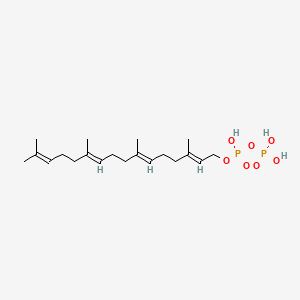
|
Geranylgeranyl diphosphate |
Geranylgeranyl diphosphate is a lipid of Prenol Lipids (PR) class. The involved functions are known as RNA Interference, Anabolism, Cytokinesis, Gene Expression and physiological aspects. Geranylgeranyl diphosphate often locates in soluble, Skeletal system, Cell-Free System, Plasma membrane and soluble fraction. The associated genes with Geranylgeranyl diphosphate are Genome, IMPACT gene, Open Reading Frames, Gene Clusters and Genes, Regulator. The related lipids are Fatty Acids, Sterols, terpentetriene and Membrane Lipids. |
885 |
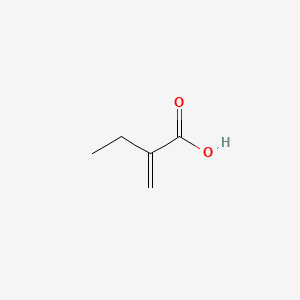
|
2-Ethylacrylic acid |
2-Ethylacrylic acid is a lipid of Fatty Acyls (FA) class. The involved functions are known as hemolysis. |
869 |
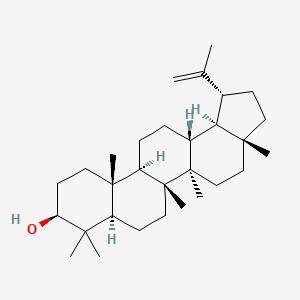
|
Lupeol |
Lupeol is a lipid of Prenol Lipids (PR) class. Lupeol is associated with abnormalities such as Morphologically altered structure, Infection, protrusion, Consumption-archaic term for TB and PARAGANGLIOMAS 2. The involved functions are known as Transcriptional Activation, Agent, Tumorigenicity, Signal and inhibitors. Lupeol often locates in Body tissue, Membrane, Cytoplasmic, Stress Fibers and Filopodia. The associated genes with Lupeol are Candidate Disease Gene, SPEN gene, AR gene, SGK1 gene and TIPARP gene. The related lipids are Sterols, Micelles, campesterol, amyrin and campestanol. The related experimental models are Mouse Model and Xenograft Model. |
844 |
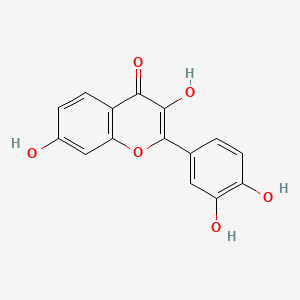
|
Fisetin |
Fisetin is a lipid of Polyketides (PK) class. Fisetin is associated with abnormalities such as Morphologically altered structure, PARKINSON DISEASE, LATE-ONSET, Tetanus, CNS disorder and Disintegration (morphologic abnormality). The involved functions are known as Autophagy, Apoptosis, Energy Metabolism, Acceleration and Anabolism. Fisetin often locates in Mitochondria, Cytoplasmic matrix, Extracellular, Cytoskeletal Filaments and Autophagic vacuole. The associated genes with Fisetin are SIRT1 gene, MAP1LC3A gene, TP53 gene, P4HTM gene and AURKB gene. The related lipids are Phosphatidylserines and Lipopolysaccharides. The related experimental models are Animal Cancer Model, Xenograft Model, Mouse Model, Cancer Model and Disease model. |
832 |

|
lysophosphatidic acid |
lysophosphatidic acid is a lipid of Glycerophospholipids (GP) class. Lysophosphatidic acid is associated with abnormalities such as Atherosclerosis, Alzheimer's Disease, Asthma, Diabetes Mellitus, Non-Insulin-Dependent and Septicemia. The involved functions are known as Inflammation, Chemotaxis, Binding (Molecular Function), Polymerization and Inflammatory Response. Lysophosphatidic acid often locates in Cytoskeleton, Microfilaments, actin cytoskeleton, Extracellular and Structure of germinal center of lymph node. The associated genes with lysophosphatidic acid are TNF gene, MAPK3 gene, RHOA gene, CDC42 gene and ADRBK1 gene. The related lipids are lysophosphatidic acid, Lipopolysaccharides, Lysophosphatidylcholines, Lysophospholipids and Phosphatidic Acid. The related experimental models are Knock-out, Transgenic Model, Rodent Model and Disease model. |
820 |
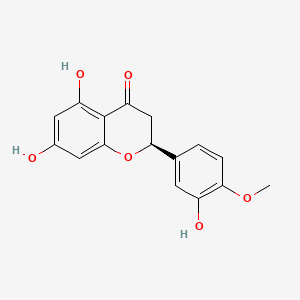
|
hesperetin |
Hesperetin is a lipid of Polyketides (PK) class. Hesperetin is associated with abnormalities such as Corn of toe, Ischemia, Osteoporosis, Consumption-archaic term for TB and Wiskott-Aldrich Syndrome. The involved functions are known as conjugation, inhibitors, Process, mRNA Expression and Adjudication. Hesperetin often locates in Entire intestinal epithelium, Protoplasm, Membrane, Shoulder and Back. The associated genes with Hesperetin are ABCG2 gene, ABCC2 gene, FATE1 gene, ABCB1 gene and P-glycoprotein 2. |
801 |
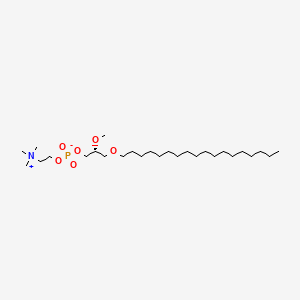
|
ET-18-OCH3 |
ET-18-OCH3 is a lipid of Glycerophospholipids (GP) class. Et-18-och3 is associated with abnormalities such as Morphologically altered structure, Choline Deficiency, Acquired partial lipodystrophy and Punctate inner choroidopathy. The involved functions are known as Mutation, establishment and maintenance of localization, Uptake, Increased Sensitivy and Process. Et-18-och3 often locates in Plasma membrane, Membrane, Back, Protoplasm and Endoplasmic Reticulum. The associated genes with ET-18-OCH3 are Genome, Alleles, ATP8A1 gene, Homologous Gene and ATPase Gene. The related lipids are Phosphatidylserines, Sphingolipids, Lysophosphatidylcholines, Phospholipid Ethers and Phosphatidate. The related experimental models are Knock-out. |
794 |



































































































